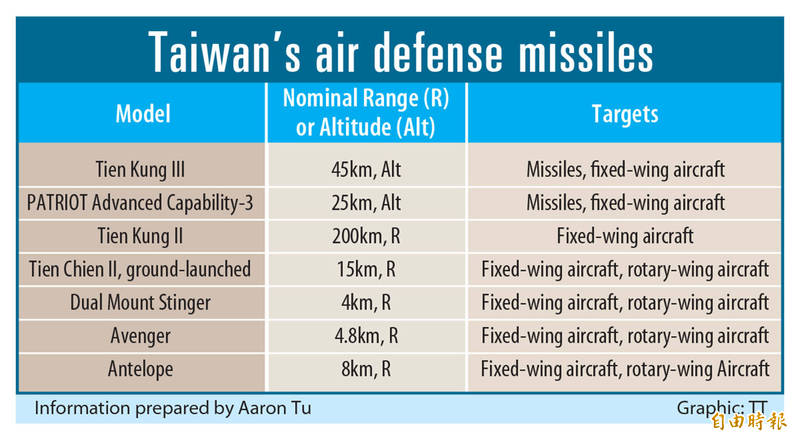《TAIPEI TIMES》 Military urged to fix system logistics
‘SLEW OF DEFICITS’: Air defense units lack an ability to transmit target data and detect highly varied targets, requiring improved integration of systems, analysts said
By Aaron Tu and Jonathan Chin / Staff reporter, with staff writer
Defense experts yesterday urged the military to improve coordination between disparate systems in Taiwan’s air defense infrastructure, and bolster abilities to counter saturation attacks.
The comments came a day after the Ministry of National Defense reported to the legislature that an extended-range version of the Tien Kung III (天弓三, “Sky Bow” III) missile has achieved initial operational capability, clearing the system for massing production.
The Washington Post earlier this month reported that Taiwan is vulnerable to Chinese air attacks due to a slew of deficits in air defense capabilities, an allegation the ministry denied.
Taiwan’s air defense systems must enhance coordination across various systems and become able to generate an integrated threat picture to defeat an increasingly complex aerial threat, Institute for National Defense and Security Research analyst Shu Hsiao-huang (舒孝煌) said.
A threat identification and detection system should be able to transmit targeting data to air defense batteries engaging the enemy and push detection range further into Chinese territory, Shu said.
Air defense units must also be able to detect and engage highly varied targets, as the Chinese People’s Liberation Army (PLA) employs diverse platforms encompassing fighter jets, helicopters and drones, he said.
The threat environment underscores the importance for long-range systems to pass targeting data to other defense batteries, which require an integrated view of the theater of battle, he said.
The Ukrainian armed forces fielded close to 100 air defense battalions, yet struggled to cope with the volume of Russian air attacks, demonstrating that mobile air defense artillery should be utilized in conjunction with high-performance missiles, he said.
A gun-based system that could shoot down drones and other targets with shells would mitigate ammunition consumption rates, thereby preventing the exhaustion of Taiwan’s missile supply, Shu said.
The US-Maneuver Short Range Air Defense system — which makes use of a 30mm gun and Stinger missiles — is one such system that Taiwan should procure, he said.
Achieving operational capability for the Tien Kung III missile is laudable, but mass-producing and integrating the weapons into field units is a vastly different challenge, retired air force lieutenant general Chang Yan-ting (張延廷) said.
The PLA’s development of hypersonic missiles and uncrewed aerial reconnaissance vehicles poses a significant challenge that the nation’s air defense capabilities might not be able to surmount, Chang said.
Instead of merely reacting to the present, the nation’s defense research and development programs should address threats that could emerge five to 10 years from now, he said.
Taiwan’s armed forces employ jets and air defense missiles to defend its air space, with the Indigenous Defense Figher, Dassault Mirage-2000 and General Dynamics F-16 being the backbone of the air fleet.
Taiwan utilizes Patriot and Tien Kung-series systems in medium to high-altitude jets and missile defense roles, while the ground-launched Tien Chien II, Stinger, Avenger and Antelope systems provide defense for lower altitudes and field units.
新聞來源:TAIPEI TIMES





















